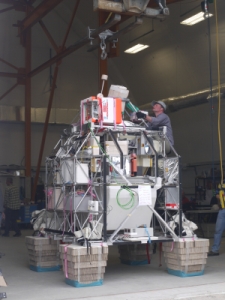How much does bromine affect stratospheric ozone? Answering this question is the primary objective of measurements by a multi-instrument gondola carried by a high-altitude balloon. The gondola accommodates a unique combination of remote sensing instruments coordinated by Karlsruhe Institute of Technology (KIT) in cooperation with the German Aerospace Center (DLR) and the University of Heidelberg. The balloon was launched from Timmins (Ontario/Canada) on Sunday, September 07, as part of the international StratoScience2014 campaign that is operated by the Canadian and French space agencies.
Bromine-containing substances can deplete the ozone layer. While half of their emission is of natural origin, the other half is caused by man, for instance by the use of fire protection materials, fire extinguishers, or pesticides. Although the abundance of bromine in the stratosphere – the second layer of the Earth’s atmosphere – is by more than a hundred times smaller than the abundance of the better-known ozone-depleting chlorine, its effect on the ozone layer is comparably hazardous. Due to a freak of nature, bromine nitrate, the reservoir for bromine, is much more easily converted into an active, ozone-destroying form as compared to the reservoir of chlorine.
Thanks to the Montreal Protocol on the reduction of production of ozone-depleting substances, which became effective in 1989, the total abundance of chlorine in the stratosphere has been decreasing since the 1990s. The total bromine concentration, by contrast, reached its maximum only a few years ago and now starts to drop very slowly. Hence, the relative hazard potential of bromine for ozone has even increased compared to that of chlorine. The amount of bromine in the stratosphere and major details of its photochemistry are less understood. So far, no simultaneous measurement of the most important bromine substances, bromine oxide (BrO) and bromine nitrate (BrONO2), has been carried out. This aggravates determination of the total abundance of stratospheric bromine to be determined and the estimation of its ozone-depleting potential.

The balloon launched from Timmins (Ontario/Canada) has a size of about 400,000 m³, it carries a load of about 760 kg, and ascends up to a height of nearly 40 km. The gondola accommodates three complex remote sensing instruments that cover a wide range of the electromagnetic spectrum. These instruments complement each other ideally in measuring stratospheric substances: The MIPAS-B infrared spectrometer of the KIT Institute of Meteorology and Climate Research – Atmospheric Trace Gases and Remote Sensing Division (IMK-ASF), the far-infrared/sub-mm spectrometer TELIS of the German Aerospace Center (DLR), and the UV/vis spectrometer mini-DOAS of Heidelberg University. “This worldwide unique combination of instruments can measure about 40 ozone- and climate-relevant trace gases simultaneously,” explains the coordinator of the balloon measurements, Hermann Oelhaf, IMK-ASF. Remote sensing means that the gases are not measured directly. Instead, electromagnetic radiation is detected. From it, atmospheric parameters are extracted, as they interact with the solar and/or terrestrial radiation.
The pointing and stabilization system of the gondola was developed by KIT’s IMK-ASF and ensures that all three instruments measure the same air masses. The remote sensing method also allows for the two- and three-dimensional daytime-dependent continuous measurement of trace gases. In this way, photochemical reactions of the species involved can be studied, which is an important prerequisite for improving chemistry and climate models. The campaign is embedded in an international balloon campaign under cooperation between the French and Canadian Space Agencies CNES and CSA.
The measurements are primarily aimed at precisely balancing in a height-dependent manner reactive bromine in the stratosphere, including the most important compounds of the bromine family, BrO and BrONO2. In addition, the researchers study how realistically the numerical models available simulate bromine photochemistry and how reliable the reaction constants measured at the laboratory are for all bromine-relevant reactions.
As the combination of MIPAS-B/TELIS/mini-DOAS can measure practically all ozone- and climate-relevant gases, the project also serves to analyze budgets, partitioning, and photochemical coupling for all chemical families and to determine vertical profiles of major climate-relevant gases. Moreover, the measurements are used to validate the active satellite devices MLS/AURA (USA) and ACE-FTS (Canada).
In the 21st century, living conditions on Earth are changing as drastically as never before. Hence, climate and environmental research is facing big challenges. More than 650 scientists of some 30 institutes of the KIT Climate and Environment Center are developing strategies and technologies to secure the natural bases of life.
Being “The Research University in the Helmholtz Association”, KIT creates and imparts knowledge for the society and the environment. It is the objective to make significant contributions to the global challenges in the fields of energy, mobility, and information. For this, about 10,000 employees cooperate in a broad range of disciplines in natural sciences, engineering sciences, economics, and the humanities and social sciences. KIT prepares its 22,800 students for responsible tasks in society, industry, and science by offering research-based study programs. Innovation efforts at KIT build a bridge between important scientific findings and their application for the benefit of society, economic prosperity, and the preservation of our natural basis of life. KIT is one of the German universities of excellence.

